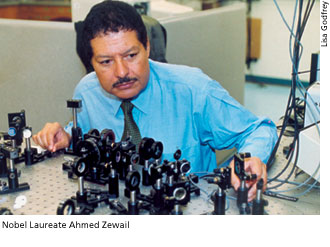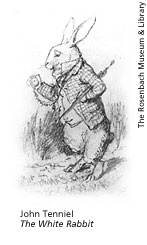
Ahmed in Femtoland
Nobel Chemist Takes an Ultra-Fast
Look at a Fleet-Footed World

For most of us, a nanosecond—one billionth of a second—defines an unbelievably
brief blink of time. We can’t really even experience such a fleeting interval,
since it’s already come and gone before we finish uttering the word Now!
But in Femtoland, Ahmed Zewail’s NSF Laboratory for Molecular Sciences,
waiting for a nanosecond to tick by is like watching water come to a boil—in
the Arctic.
Disney Magic
Zewail, Gr’74, Hon’97, is the Linus Pauling Professor of Chemistry and
Physics at Caltech. Born and educated in Egypt, he came to Penn for graduate
study in chemistry and has spent almost all of his research career at
the California Institute of Technology.
In a moment of whimsy, his grad students dubbed their research facility "Femtoland," mostly because Disneyland is nearby in Anaheim. But the high-tech, pin-point-precision-timed science pursued in Femtoland holds more than a little of the famed amusement park’s dazzle and magic.
If you were to enter one of the labs while an experiment was underway, you would see darkness cut across with bright-colored lines of laser light bouncing from mirrors, bending through prisms, and crisscrossing among the funfair of scientific apparatus. The instruments were designed to capture something that had previously only been rendered in leaps of imagination that scientists call theory.
 Twenty-five
centuries ago, Democritus first put forward the stunning materialist claim
that everything is made of "only atoms and the void." Change, he argued,
consists of intricate permutations in the arrangement of these uncutable,
invisible bits of matter.
Twenty-five
centuries ago, Democritus first put forward the stunning materialist claim
that everything is made of "only atoms and the void." Change, he argued,
consists of intricate permutations in the arrangement of these uncutable,
invisible bits of matter.
It wasn’t until modern times that atomic theory came to be widely accepted, but the atom remained a theoretical construct. No one had actually seen one. A more detailed picture began to emerge as researchers painted the contours of its structure and behavior with more sophisticated experiments.
Atoms cling together to form molecules, which are the smallest specks of matter that still carry the unique makeup and traits of a chemical substance. A chemical reaction is the coming together of atoms into molecules or the dissolution of that embrace. But "for centuries," states the Caltech scientist, "our vision of atoms continued to be largely imaginary and speculative."
Thanks to Zewail, the Swedish Royal Academy noted when he was awarded the 1999 Nobel prize for chemistry, "we can now see the movements of individual atoms as we imagine them. They are no longer invisible."
Chemistry
Itself
In 1901, Dutch chemist Jacobus Van’t Hoff was awarded the first
Nobel prize for chemistry, in part, for defining some mathematical laws
that describe chemical reactions. The 1903 laureate, Svante Arrhenius,
worked out the formula that expresses how reaction speed increases with
temperature. In those days, the most efficient experimenters, with stopwatch
and notepad, could track chemical processes that unfolded over seconds.
In the 1930s, Henry Eyring and Michael Polanyi formulated transition state theory, which predicted that the interval between reactants and products in a reaction would be crossed in an instant.
Linus Pauling used X-ray crystallography and electron diffraction to lay out the geometrical configuration of atoms bound in a molecule, earning the 1954 Nobel. Pauling’s important step dramatically advanced our knowledge of atoms locked in molecules, but chemistry is about motion: the nuptials of atoms and their rituals of separation as one substance transmutes into another. "Modern scientists had never seen atoms in motion," Zewail stresses, "and had only the faintest idea of what chemical interactions would do to the motion in real time and on the atomic and molecular level."
 Manfred
Eigen shared the 1967 Nobel for pioneering "fast" methods using flash
lamps and temperature jumps to follow reactions in increments of one-millionth
of a second. But snatching hold of even these tiny grains of sand sifting
through time’s hourglass was not enough. Within the microsecond he had
managed to mark out, the White Rabbit would have already hurried by and
disappeared down the rabbit hole. He wasn’t even a blur, and researchers
were left with only the dying echoes of his worried refrain: "Oh dear!
Oh dear! I shall be too late."
Manfred
Eigen shared the 1967 Nobel for pioneering "fast" methods using flash
lamps and temperature jumps to follow reactions in increments of one-millionth
of a second. But snatching hold of even these tiny grains of sand sifting
through time’s hourglass was not enough. Within the microsecond he had
managed to mark out, the White Rabbit would have already hurried by and
disappeared down the rabbit hole. He wasn’t even a blur, and researchers
were left with only the dying echoes of his worried refrain: "Oh dear!
Oh dear! I shall be too late."
Catching chemistry itself seemed far off or impossible, consigned forever to the realm of theory and equations, supplemented with imagination. In his Nobel acceptance speech, Eigen spoke of "immeasurably fast reactions."
Measuring
the Immeasurable
"The key thing for any decisive moment in the life of molecules
and reactions," explains Zewail, "is to understand the moment called the
transition state…. Chemistry is a science of transformation. The only
way to see it is to travel with time during the transformation, and that
happens to be the timescale in which atoms move inside molecules." To
peer into the fleet-footed instant of the transition state, undaunted
theorists postulated that a molecular motion picture would need to resolve
happenings in femtosecond time increments.
Calling a femtosecond brief enshrines in plain language the failure of words to capture scientific wonders, just as cosmologists did when they dubbed the birth of the universe the Big Bang.
Divide one second into nanoseconds. Then take one of those billionth-of-a-second pieces and break that into a million time units. One of those 10-15 fragments is a femtosecond—a quadrillionth of a second. Another way of putting it is that a femtosecond is to a second what one second is to 32 million years.
That’s what Zewail and his Caltech group went after—a strobe femtoscope, a "camera" that could illuminate and capture the movement of atoms in stop-motion photographs. He even had to invent a name for the undertaking: femtochemistry—femto, from the Scandinavian root for 15 (femten).
"The breakthrough came in 1987," he reports, "when [our] laser pulses reached a time less than the vibrational period of a molecule," which ordinarily runs in the tens of femtoseconds.
 The
technique involves firing a laser at the molecules of reactant Zewail
wants to watch undergo chemical change. The first or "pump" pulse of laser
light excites the molecule, pushing it to a higher energy state, which
jump starts the chemical reaction. The next or "probe" pulse is essentially
the flash that freezes the action. The pump and the probe are from the
same laser beam, but experimenters can fine tune the time between the
pulses by diverting part of the light path with mirrors.
The
technique involves firing a laser at the molecules of reactant Zewail
wants to watch undergo chemical change. The first or "pump" pulse of laser
light excites the molecule, pushing it to a higher energy state, which
jump starts the chemical reaction. The next or "probe" pulse is essentially
the flash that freezes the action. The pump and the probe are from the
same laser beam, but experimenters can fine tune the time between the
pulses by diverting part of the light path with mirrors.
The laser doesn’t actually take photographs, but the fast-changing spectra of light that emerge when the probes strike the reacting molecule tell scientists at each femtostage whether the atoms are cleaving together or moving apart. Infinitesimal variations in the absorption or radiation of specific wavelengths contain information about not only which atoms are present but where they have moved since the previous probe struck.
Breaking a molecular bond, it turns out, is less straightforward than the sudden snap of a stick. It proceeds with all the ambivalence of a broken marriage.
In an experiment with sodium iodide, which Zewail calls a "paradigm case for the field of femtochemistry," the team watched sodium and iodine atoms begin to fly apart when the molecule was hit with the pump pulse. As probes of laser light monitored the reaction frame by frame, the atoms came back together and stretched apart again. "We could see for the first time a chemical bond transforming in real time," says Zewail, "from covalent to ionic, covalent, ionic, covalent, ionic—with an electron jumping back and forth between the atoms. They were in love for about nine or ten cycles before they divorced each other in the end. The sodium-iodide marriage took about eight picoseconds [8,000 femtoseconds] to fall apart—a long-term commitment on the atomic scale."
The Nobel committee called Zewail’s femtosecond spectroscopy "the world’s fastest camera." Its rapid-fire shutter speed yields enough close-packed, spectrographic frames that the reassembled snapshots create a "movie" chronicling the birth and death of molecules. "It lets us watch the fundamental chemical act, as it’s happening," he says.
Empiricism
and Wonder
Today, femtosecond techniques are being applied in research
laboratories all over the world. Scientists have adapted ultrafast lasers
to probe the chemistry of photosynthesis and to watch the motion of atoms
in DNA. Others have been scrutinizing the molecular mechanics of vision.
"If we can show that we can control the kind of complex molecules the
chemical industry uses," adds Zewail, "the impact will be enormous."
At the award ceremony, Professor Bengt Nordén of the Noble committee presented Zewail to King Gustaf by likening his fast-laser femtoscope to Galileo’s telescope. Galileo, he noted, directed his instrument "towards everything that lit up the vault of heaven. Zewail tried his femtosecond laser on literally everything that moved in the world of molecules. He turned his ‘telescope’ towards the frontiers of science."
A century ago, Van’t Hoff and Arrhenius captured chemistry in a string of mathematical symbols. Zewail broke open the Now! of the transition state, demonstrating that an instant has a history with a long and rich and detailed succession of moments. With his telescope, Galileo revealed the ballet of moons and planets that lay behind the music of the spheres. By showing us the fairy dance of atoms hidden beneath the alchemy of change, Zewail set chemistry more firmly upon its empirical foundations. He reminds us that in observation and discovery, there is magic as well as rigor, and that wonder too is a keystone of science.